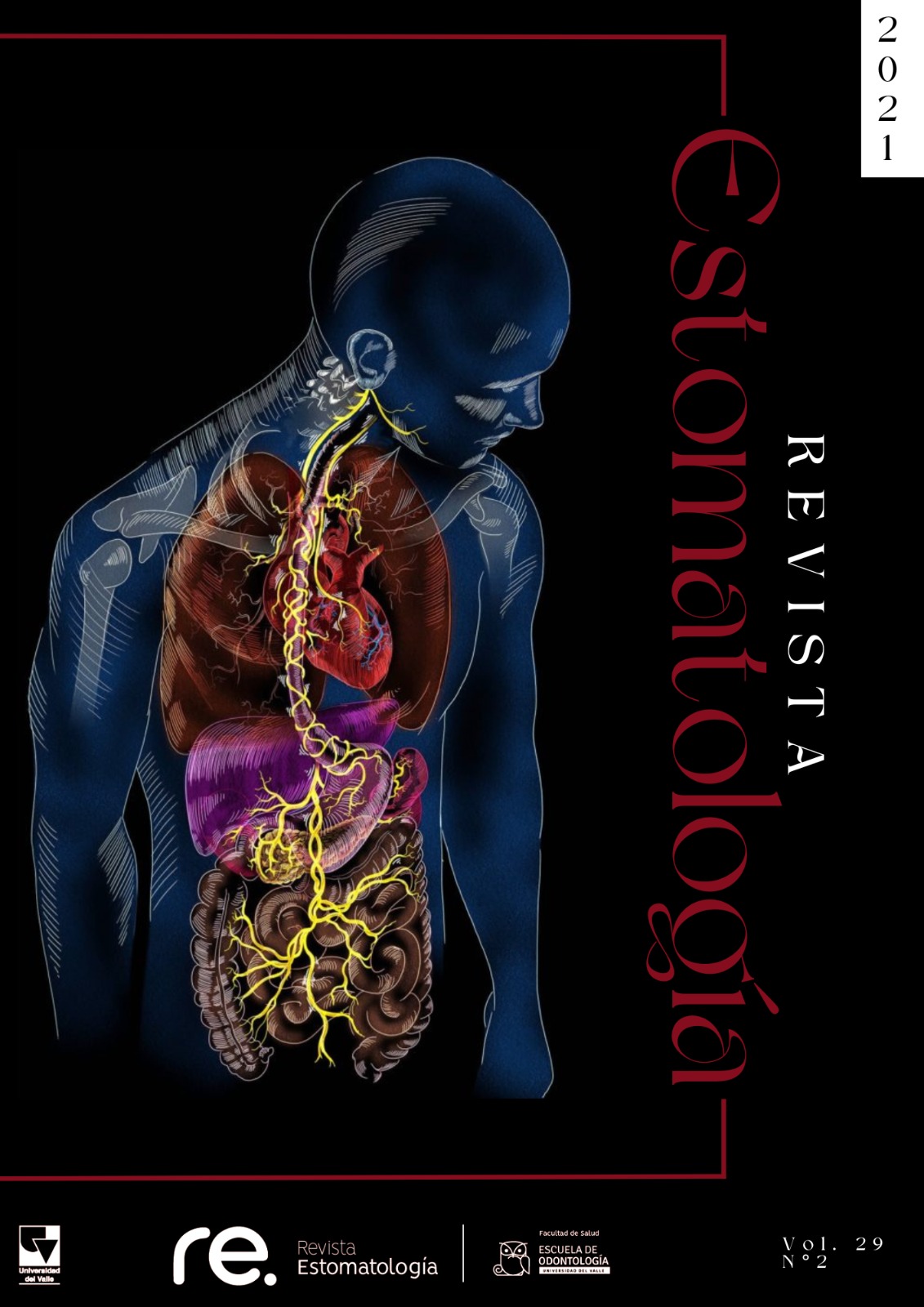Skeletal class III correction in growing patient with bone anchorage: Case Report
Keywords:
Skeletal class III, dental orthopedics, maxillary protraction, bone anchorage, early treatmentMain Article Content
Background: Skeletal class III is a dentofacial deformity where the lower third of face is more prominent. The treatment is decided according to the etiology and age of the patient; If the patient is in growing, the malformation can be treated with an interceptive protocol and if possible, avoid a orthognathic surgery in the future.
Objective: Improve the skeletal class, uncross the bite or obtain an edge-to-edge bite, improve the position of the upper lip and evaluate the initial-final relationship of ANS and ANB.
Case report: 13-year-old male patient, with no reported pathological or family history; presents skeletal class III, vertical growth, molar class I and canine III; he was treated with the protocol of mini BAMP (bone anchored maxillary protraction) plates, intermaxillary elastics and a palate with flat tracks.
Results: The orthopedic phase lasted five months and an edge-to-edge bite and skeletal class I were achieved.
Discussion: Results were obtained with the use of mini implants without extraoral anchorage in less time compared to other methods that have to be used for 9-12 months.
Conclusion: The BAMP protocol can be used in growing patients without a face mask to correct skeletal class III.
Espinar-Escalona E, Ruiz-Navarro MB, Ortega-Rivera H, Llamas-Carreras JM, Barrera-Mora JM, Solano-Reina JE. Tratamiento temprano de las Clases III. Rev Esp Ortod. 2011;41:79–89.
Ramírez-Mendoza J, Muñoz-Martínez C, Gallegos-Ramírez A, Rueda-Ventura MA. Maloclusión clase III. Salud en Tabasco. 2010;944–50.
Reyes-Ramírez DL, Etcheverry-Doger E, Antón-Sarabia J, Muñoz-Quintana G. Asociación de maloclusiones clase I, II y III y su tratamiento en población infantil en la ciudad de Puebla, México. Revista Tamé. 2014;2(6):175–9.
Zere E, Chaudhari PK, Sharan J, Dhingra K, Tiwari N. Developing Class III malocclusions: Challenges and solutions. Clin Cosmet Investig Dent. 2018;10:99–116.
Clemente R, Contardo L, Greco C, Di Lenarda R, Perinetti G. Class III Treatment with Skeletal and Dental Anchorage: A Review of Comparative Effects. Biomed Res Int. 2018;2018:1–10.
D’Escriván de Saturno L. Ortodoncia en dentición mixta. 2da Edició. Orthodontics WJ of, editor. Venezuela: Amolca; 2007. 1–555 p.
Ngan P, Wilmes B, Drescher D, Martin C, Weaver B, Gunel E. Comparison of two maxillary protraction protocols: tooth-borne versus bone-anchored protraction facemask treatment. Prog Orthod. 2015;16(26):1–11.
Pereira da Silva HCF, de Paiva JB, Rino Neto J. Anterior crossbite treatment in the primary dentition: Three case reports. Int Orthod. 2018;16(3):514–29.
Proffit WR, Fields HW, Sarver DM, Ackerman JL. Ortodoncia Contemporánea. 5ta Edició. Elsevier, editor. España; 2013. 770 p.
Martinez Smit R, Aristizábal JF. Maloclusión Clase III : Diagnóstico y Tratamiento Ortopédico . Revisión de Literatura y Reporte de Caso. Revista Cientifica Sociedad de Ortodoncia. 2016;3(2):7–17.
De-Clerck H, Cevidanes L, Baccetti T. Dentofacial effects of bone-anchored maxillary protraction: A controlled study of consecutively treated Class III patients. J Orthod Dentofac Orthop. 2010;138(5):577–581.
De Clerck H, Cornelis MA, Cevidanes LH, Heymann GC, Tulloch CJF. Orthopedic Traction of the Maxilla with Miniplates: A New Perspective for Treatment of Midface Deficiency. J Oral Maxillofac Surg. 2009;67(10):2123–9.
Şar Ç, Arman-Özçirpici A, Uçkan S, Canan-Yazici A. Comparative evaluation of maxillary protraction with or without skeletal anchorage. Am J Orthod Dentofac Orthop. 2011;139(5):636–49.
Degala S, Bhanumathi M, Shivalinga BM. Orthopaedic Protraction of the Maxilla with Miniplates: Treatment of Midface Deficiency. J Maxillofac Oral Surg. 2015;14(1):111–8.
Cornelis MA, Tepedino M, De Vos-Riis N, Niu X, Cattaneo PM. Treatment effect of bone-anchored maxillary protraction in growing patients compared to controls: a systematic review with meta-analysis. Eur J Orthod. 2020 Aug 20;1–18.
Sahin T, Delforge A, Garreau E, Raoul G, Ferri J. Orthopedic treatment of Class III malocclusions using skeletal anchorage: A bibliographical review. Int Orthod. 2016;14(3):263–72.
Mohamed-Eid O, Abdel-Fattah Ramadan A, Adel-Nadim M, Abdel-Bary-Hamed T. Maxillary protraction using orthodontic miniplates in correction of Class III malocclusion during growth. J World Fed Orthod. 2016;5(3):100–6.
Van Hevele J, Nout E, Claeys T, Meyns J, Scheerlinck J, Politis C. Bone-anchored maxillary protraction to correct a class III skeletal relationship: A multicenter retrospective analysis of 218 patients. J Cranio-Maxillofacial Surg. 2018;46(10):1800–6.
Cevidanes L, Baccetti T, Franchi L, McNamara JA, De Clerck H. Comparison of two protocols for maxillary protraction: Bone anchors versus face mask with rapid maxillary expansion. Angle Orthod. 2010;80(5):799–806.
Fakharian M, Bardideh E, Abtahi M. Skeletal class iii malocclusion treatment using mandibular and maxillary skeletal anchorage and intermaxillary elastics: A case report. Dental Press J Orthod. 2019;24(5):52–9.
De Clerck H, E.B E, Swennen G-RJ. Success rate of miniplate anchorage for bone anchored maxillary protraction. Angle Orthod. 2011;81(6):1010–3.
Miranda F, Da Cunha-Bastos JC, Magno-Dos Santos A, Vieira LS, Aliaga-Del Castillo A, Janson G, et al. Miniscrew-anchored maxillary protraction in growing Class III patients. J Orthod. 2020;47(2):170–80.
Elnagar MH, Elshourbagy E, Ghobashy S, Khedr M, Evans CA. Comparative evaluation of 2 skeletally anchored maxillary protraction protocols. Am J Orthod Dentofac Orthop [Internet]. 2016;150(5):751–62. Available from: http://dx.doi.org/10.1016/j.ajodo.2016.04.025
Downloads

This work is licensed under a Creative Commons Attribution-NonCommercial-NoDerivatives 4.0 International License.
Los autores/as conservan los derechos de autor y ceden a la revista el derecho de la primera publicación, con el trabajo registrado con la licencia de atribución de Creative Commons, que permite a terceros utilizar lo publicado siempre que mencionen la autoría del trabajo y a la primera publicación en esta revista.


 https://orcid.org/0000-0001-6832-1968
https://orcid.org/0000-0001-6832-1968 https://orcid.org/0000-0002-6128-0945
https://orcid.org/0000-0002-6128-0945 https://orcid.org/0000-0002-8731-5368
https://orcid.org/0000-0002-8731-5368 https://orcid.org/0000-0002-9424-2718
https://orcid.org/0000-0002-9424-2718 https://orcid.org/0000-0002-1947-0155
https://orcid.org/0000-0002-1947-0155 https://orcid.org/0000-0003-0288-9117
https://orcid.org/0000-0003-0288-9117